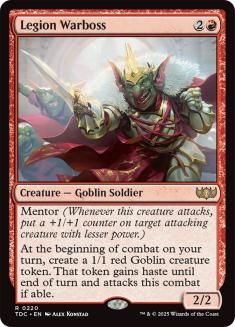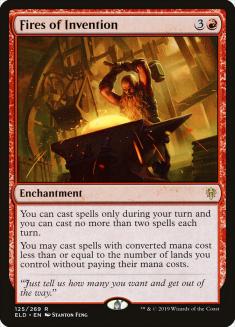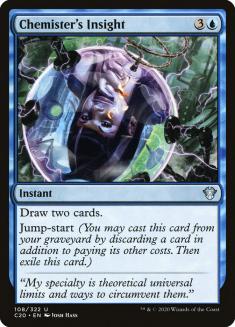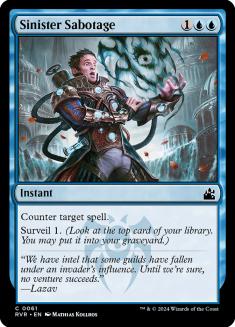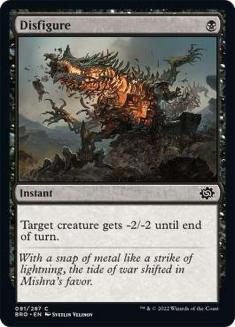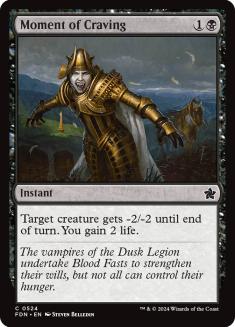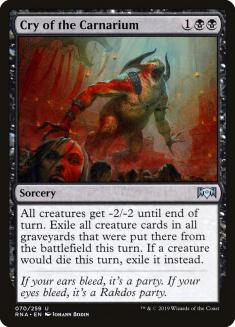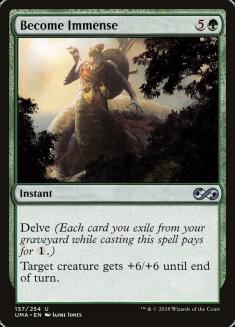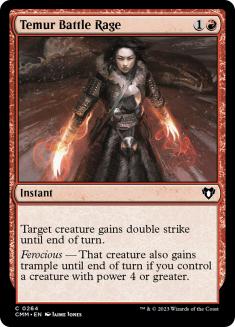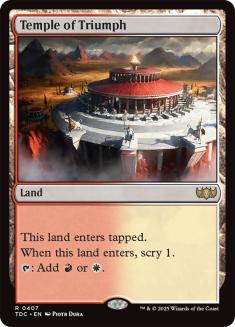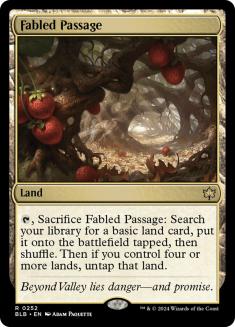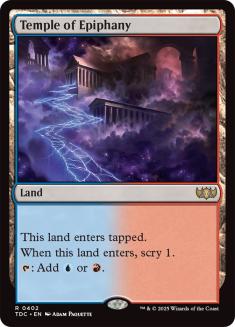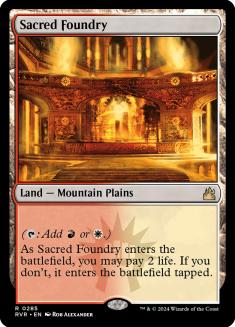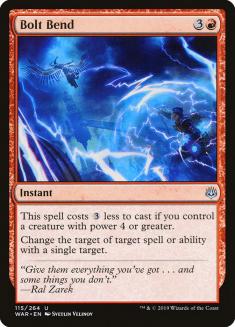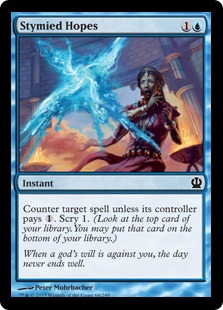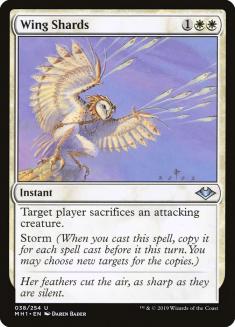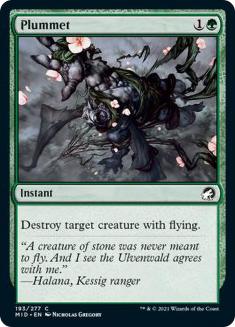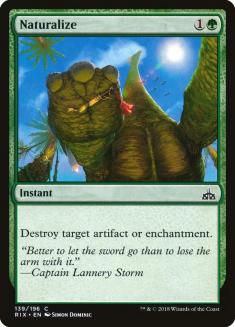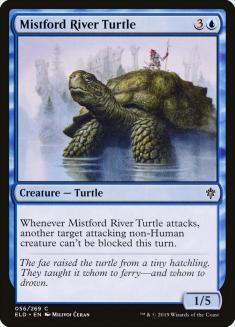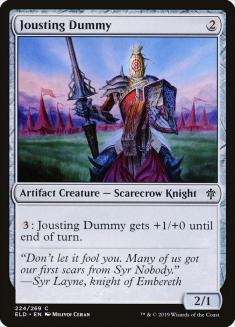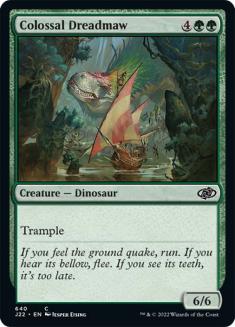Right now, information in Magic is very widespread. Between tournament results, articles, and streams, the top decklists are basically public domain, which means it’s hard to get an edge due to having a better deck than everyone else. Because of that, one of the best ways to gain an edge is through sideboarding.
Almost every top deck you find will have a sideboard guide attached to it. While sideboard guides are very useful and will get you far, they are often meant as “cheat-sheets”, and because of this are not very comprehensive; they will tell you what you need to know for each major matchup, but no more. Today, I’ll talk about some important sideboard concepts that can be applied on top of a sideboard guide to take your game to the next level.
Sideboard Differently on the Play and on the Draw
Most sideboard guides will not differentiate between play and draw, but most top players will sideboard differently depending on whether they’re going first or second. I often make it a point to mention it in my guides when the difference is very big, but it’s still something that people don’t do often enough.
Simply put, a game where you’re on the play is very different from a game where you’re on the draw. In Game 1s there’s no way to account for that, as you don’t know if you’ll be on the play or on the draw, but in Games 2 and 3 you always know, and if you don’t make use of that information you’re just throwing a resource away.
The big heuristic that I use here is that on the play I like to be proactive, and on the draw I like to be reactive. If I’m playing first, I will configure my deck to be the best at doing its primary gameplan — since I’m going first, I will execute my gameplan first, and this is probably my best chance of winning. This means I often sideboard less on the play than I do on the draw, because I want to keep the core of my deck intact.
On the draw, things change. If I try to just do my thing, I’ll be second to everything and I might just lose to their deck’s primary gameplan before I have time to execute mine. Because of this, on the draw I like to be more reactive — I know I am unlikely to win the game on speed alone, so I need to prolong it and win on another axis.
Creatures (17)
Planeswalkers (7)
Lands (26)
Spells (10)

To give you an example, we can take Ondrej Strasky sideboard plan for mirrors in the Mythic Championship he won with Simic Food. On the play, Ondrej sideboarded minimally — he would keep all of his core cards and hope his Plan A was good enough. On the draw, however, Ondrej didn’t trust that he’d be able to win with his standard configuration — after all, his opponent would just do the same thing but earlier. Instead, he filled his deck with more reactive cards, such as Mystical Dispute, and trimmed proactive cards like Nissa, Who Shakes the World. Ondrej beat many mirrors throughout that tournament, and so did I with a similar strategy.
Another example of this is the Jeskai Fires mirror. On the play, I liked having a proactive gameplan, because I felt like if I just assembled my combo earlier then that be enough to win. I didn’t care about answering a card like Legion Warboss because I didn’t need to answer anything; I just needed to play Fires of Invention. On the draw, on the other hand, suddenly casting Fires of Invention wasn’t good enough — I also had to stop them from casting their Fires first and I had to stop them from playing Legion Warboss and killing me with it, so I needed to have some disruptive elements.
There are also certain types of cards that are much better on the play than on the draw — namely planeswalkers. Casting a planeswalker into an empty or even battlefield is much better than casting one when you’re behind and it’s just going to die. This applies to the aforementioned Nissa, Who Shakes the World, but it also applies a lot to cards like Teferi, Time Raveler or Narset, Parter of Veils in matchups where they can attack them. On the play, Teferi is very likely to just reset the battlefield against most people, whereas on the draw it’s merely a nuisance that will immediately die. My sideboard plan with a lot of decks that contain Teferi includes keeping them all in on the play and cutting some or all of them on the draw.
You should also consider how the cards you have match up with the cards your opponent is going to have, on the play or on the draw. For example, back in the Goblin Chainwhirler days, it was very common for me to keep Llanowar Elves in against a Chainwhirler deck if I was on the play, but to take them all out on the draw. On the play, I felt that having two turns to use your Llanowar Elves was enough to justify them, plus I wanted to get ahead quickly, which means I was willing to have them incidentally die to Goblin Chainwhirler. On the draw, however, I didn’t need to be as fast, and that combined with the fact that I’d only get one use out of a Turn 1 Llanowar Elves meant the card wasn’t good enough.
Another very important distinction that goes mostly ignored, even among the best players, is the fact that you need fewer lands on the draw than you do on the play. For example, say we would like to cast a four-drop by Turn 4 with 70% regularity. If we’re on the play, we accomplish this by playing 26 lands (71% chance). If we’re on the draw, we only need 24 lands to get to 72% — that’s two fewer lands that need to be in our deck. I believe this number remains relatively constant.
Of course, this doesn’t mean you should take out two lands on the draw every time — there are other factors to consider as well, such as opening hands and colored mana (plus the fact that the number of lands in your deck is likely optimized for an average of being on the play half the time, not all the time). But it does mean that you should consider, sometimes, taking out a land on the draw.
Sideboard Against Your Opponent’s Sideboarded Deck, Not Against Their Game 1 Deck
When we sideboard, we often consider what our deck is going to look like, but we don’t take into account that the opponent’s deck is also changing. For example, imagine you’re playing a control deck against a red aggro deck; you decide you need cheap answers for their creatures, so you take out a lot of control cards and bring in cheap removal (for example, they could take out Negate, Chemister’s Insight, and Sinister Sabotage for Disfigure, Moment of Craving, and Cry of the Carnarium).
This might be a good thing to do in a Game 1 scenario, but is it really the best way to beat their sideboarded configuration? It might be, but it might not be. Historically speaking, a lot of aggro decks go slightly bigger post-sideboard; your opponent could bring in planeswalkers like Chandra, Torch of Defiance, or they could bring in a card like Experimental Frenzy, or go even bigger with some sort of Dragon. If they do these things, you might wish you had Negate in your deck instead of Cry of the Carnarium, for example, even though this would never be true in Game 1. It’s not always obvious what they will sideboard if you don’t know their exact list, but most decks in a format follow specific trends, since there aren’t that many sideboard plans for a deck to choose from, so you should be able to predict at least which direction they’re going.
My favorite example from this phenomenon comes from Pro Tour Atlanta, where the “deck to beat” was a Mono-Red deck that splashed for Become Immense, which it used to combo with Temur Battle Rage for an incredible burst of damage.
This combo was good versus almost everyone, but it was bad in the mirror, because it was too easy to stop with Shock or Lightning Strike (or whichever version of Lightning Strike was legal at the time). So, most people’s sideboard plan in the mirror consisted in removing the combo and bringing in grindy cards that are traditionally good in red mirrors: Hordeling Outburst, Outpost Siege, Thunderbreak Regent.
For a while, this was our plan as well; the best way to beat these Red decks was to go over the top of them and present more threats, so we had our own Tunderbreak Regents and Hordeling Outbursts. However, after testing a little more, we had our breakthrough — the combo of Become Immense and Temur Battle Rage was quite bad versus red decks, but it was bad versus the Game 1 configuration of red decks, since they had all this cheap removal. Once they sideboarded into this Big Red deck, with multiple three- and four-drops, they were forced to tap out and we could just kill them with the combo!
In this scenario, other people were sideboarding against the Game 1 configuration of the Red deck, whereas we were sideboarding against their Game 2 configuration. This gave us a big edge and we lost very few mirrors in the tournament with the revolutionary sideboard plan of not sideboarding at all.
Mulligan Differently in Sideboarded Games
Most of the time, people change the contents of their decks in a sideboarded game but they don’t adjust how they play to accommodate the fact that you’re now playing an entirely different matchup. This is mostly seen on mulligan decisions, which should change for Games 2 and 3.
As a general rule, sideboarded games are more grindy than Game 1s. This isn’t going to be the case all the time but it’s the case enough of the time that I consider it a good heuristic to follow. Game 1s are usually more about speed and card quality, and Game 2s and 3s are usually more about card quantity, because people just bring in more answers. It makes sense once you think about it, since the answers are the cards that are situational and you cannot risk having in Game 1 — most of the good threats are already being played in the maindeck, so decks are bound to have more answers for Games 2 and 3.
In Game 1s, I’m more likely to mulligan aggressively for a hand that is more explosive, knowing that all I need to do is find a specific card and it might bail me out of a mulligan to six or five. Post-sideboard, my opponent is more likely to be able to interact with said card, so mulliganing for it might be too punishing.
Let’s take Jeskai Fires again as an example. During the latest Mythic Championship, I kept a hand that most people considered bad — it had lands, interaction (Justice Strike if I recall), and five-drops. I wouldn’t have kept it in Game 1, where finding and resolving Fires of Invention is paramount, but I knew my opponent would be adding in Duresses and Thrashing Brontodons, so the game was necessarily going to be more grindy, which would have made a mulligan more punishing. It was a close decision, and it might have been wrong, but the real key here is that I thought about it and adjusted the hand based on the fact that we had already sideboarded, whereas the decision would have been automatic Game 1.
Another example — imagine you’re playing Jeskai Fires and it’s Game 1 against Golgari Adventures. You mulligan once and this is your hand:
This isn’t a great hand, but I would certainly keep it rather than going to five. I’d also automatically put Fires of Invention on the bottom for my mulligan because Golgari Adventures cannot deal with the card, so extra copies are useless.
For Game 2, however, they’re likely bringing in Duress and a combination of Assassin’s Trophy and Thrashing Brontodon. This means they can interact with Fires of Invention, which means the second copy is no longer redundant. In a post-sideboard game, I would adjust my thinking and put a land back instead.
Sideboard Differently Versus Different Opponents
Whenever I play a tournament, I almost never sideboard identically versus all my opponents with the same deck. People play the game differently from one another, and they also have different lists, and if you don’t adapt to that you’re doing yourself a disservice. Usually, when you see a sideboard guide, it accounts for the most popular list, but you might be playing against something slightly different, or the person might have a different play style, and you might be able to identify that during your match (either because of some card they played or because you know their decklist). Here are some recent situations where I adapted my sideboarding to the list or person I was playing:
- At the latest Mythic Championship, I played versus Piotr Glogowski with Jund Sacrifice. Normally, my sideboard plan for Jund Sacrifice involved keeping some number of Deafening Clarions, but they seemed particularly bad against Piotr (he had no Paradise Druids, for example). So, when we played, I just cut the Clarions.
- At the Mythic Championship before that, when I played against Ondrej Strasky, I added Questing Beast in the mirror. I only did this for a game in which I was on the play, and only because I knew Ondrej would take out his Wicked Wolves. I didn’t sideboard it in versus any other Food deck in that tournament.
- In the quarterfinals of Pro Tour Kyoto against Seth Manfield, we were both playing Mono-Red, and my original plan for the mirror was to go slightly bigger. However, once I looked at the decklists, I realized he had an even better “go big” plan than I did, which meant I basically reverted back to my original configuration and tried to aggro him out.
- A while ago, I was playing an Azorius deck in a Grand Prix against an opponent on Rakdos. I had two Settle the Wreckage in my maindeck and one more in the sideboard, and my sideboard plan against Rakdos included bringing in the third copy. However, during my Game 1, my opponent played around Settle the Wreckage at every point they possibly could; they never attacked with more than one creature when I had four open mana. I suspected they would do the same for Game 2, so instead of sideboarding Settle the Wreckage in, I actually sideboarded Settle the Wreckage out.
- In my past Limited tournaments, I would often sideboard out a combat trick or counterspell that a particular opponent had already seen. Cards like Bolt Bend, Stymied Hopes, and Wing Shards all become much worse when your opponent knows for a fact you’re playing them, and you can often side them out and still get some of the effect, as they’re likely to play around them anyway.
Sideboard More in Limited
I sideboard more than almost anyone I know in Limited, and the reason is that I have a wider range for what I would consider a sideboard card. With some cards, it’s very easy:
There are cards, however, that don’t scream “Sideboard me!” but are actually great options in specific matchups. For example:
Basically, my philosophy with sideboarding in limited is that, if you have power and toughness, you’re a sideboard card. Actually, just toughness works too — I’ve sideboarded in Yoked Ox equivalents plenty of times.
Usually, in Limited, there is a “sweet spot” for power and toughness — there are cards that simply align better against the rest of the format, and these are the ones you maindeck. For example, in Core Set 2020, one toughness was a poor statline because there were many ways to deal one damage to a creature. In Throne of Eldraine, four power is at a premium because it attacks through Merfolk Secretkeeper and Corridor Monitor, two cards that defensive decks often rely on. These are just generic characteristics, though, and sometimes your opponent shows you a deck that bends these particular breakpoints — and when they do, you need to adapt. If your opponent’s deck doesn’t contain any of the cards that punish one-toughness creatures, there’s no reason you shouldn’t have them.
For example, Mistford River Turtle is not a good card, but if your opponent’s deck is all 2/1s, 3/1s and 4/4s, you probably want to sideboard it in. Jousting Dummy is not a card you’ll play in a defensive deck very often, but if your opponent played several Embereth Paladins and Wicked Guardians, it’s possible a 2/1 creature is actually more valuable than a 1/4, so you can sideboard it in for a Corridor Monitor. You’ll often not play your third Colossal Dreadmaw, but maybe your opponent is playing a particularly slow deck with a lot of removal and you aren’t afraid of dying with six-drops in your hand, so it’s fine to have multiples.
Another thing that almost no one does (and I really mean almost no one) is changing their manabase in sideboarded games. Sometimes you see players cutting two seven-drops for two-drops against an aggro deck and they stay at 18 lands just because they didn’t think to cut one. Sometimes people will take out three blue cards for three black cards but keep a 9/8 manabase when they should likely make a modification to their basics at some point.
All of this is to say that you should broaden your horizons when it comes to sideboarding. Do use sideboard guides — they are good resources — but don’t be a slave to them. Each match of Magic is different — who is on the play, what the decklist looks like, who your opponent is and how they played in Game 1, and even how much time there is on the clock are all factors that make a match unique, and if it’s unique, so should be your sideboard plan.

